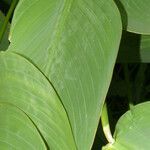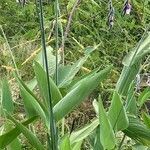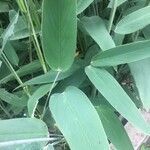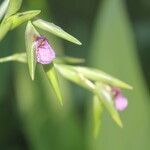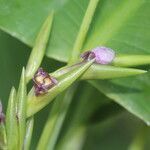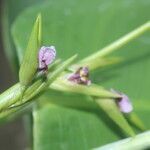Plants 1--3.5 m. Leaves: basal 2--6, cauline 0--1(--2); sheath green or occasionally red-purple, glabrous; petiole green or occasionally red-purple, glabrous; pulvinus caramel-colored, olive-green, or red-purple, 0.3--2.5 cm, glabrous; blade ovate to narrowly ovate, 19--60 ´ 4--26 cm, firm, stiff-papery, base rounded to subtruncate, apex acute to acuminate, occasionally obtuse with acuminate tip, abaxial surface green, faintly pruinose, glabrous, adaxial surface glabrous. Inflorescences lax, broadly spreading to pendeant, paniclelike array, up to ca. 0.6 1 m; scapes 0.8--2.5 m; rachis not pruinose; internodes 5--20 mm; bracts not pruinose, green or streaked or tinged with purple, narrowly ovate, 1.3--2.8 cm, herbaceous, sparsely to densely villous. Flowers: sepals 0.5--2 mm; outer staminode faint lavender to purple, 15--20 ´ 5--10 mm; callose staminode base yellow, apex purple, apical rim, reflexed, petal-like. Fruits ellipsoid, 9--12 ´ 6--7 mm. Seeds smooth dark brown to black, ellipsoid, 7--10 ´ 5--6 mm. 2n = 18 (Senegal) 2n = 26 (in cultivation).
More
Plants rather stout, 2-4 m. tall; leaves ovate to ovate-lanceolate, 20-75 cm. long, 5-30 cm. broad, gradually and narrowly to very abruptly and shortly acuminate, base obtuse to rounded, glabrous; petiole 30-50 cm. long, the callus very short; sheath 30-100 cm. long; inflorescence diffusely panic-ulate, many-flowered, the rachis slender and sharply zig-zag, with internodes 0.5-1.0 cm. long; bracts oblong-lanceolate, 1.0-2.5 cm. long, foliaceous, caducous immediately after anthesis; flowers about 1.5 cm. long, the outer staminodium purple.
A plant that grows in water. It keeps growing from year to year. It grows 3 m high. It forms dense clumps. The leaves are arrow shaped and 1 m long by 20 cm wide. . They are on thin stems. The flowers are purple and white. They are on zig-zag stems.
